Common nicknames Spinone AKC Sporting Hypoallergenic No | Origin Italy Sporting standard Life span 12 – 14 years | |
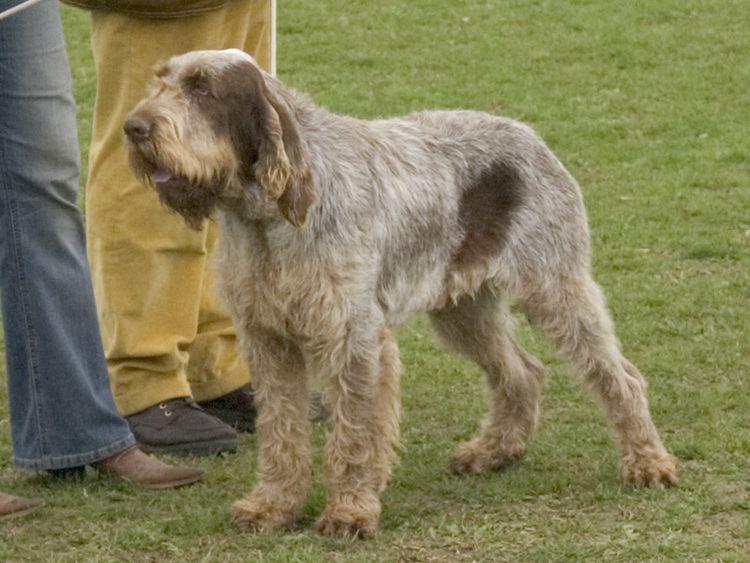 | ||
Other names SpinoneItalian SpinoneItalian GriffonItalian Wire-haired PointerItalian Coarsehaired Pointer FCI Group 7, Section 1.3 Continental Pointing Dogs: Griffon type #165 Temperament Affectionate, Docile, Loyal, Gentle, Friendly, Patient Height Female: 59–65 cm, Male: 60–70 cm Colors White, Orange Roan, Brown Roan, Orange & White Weight Female: 29–34 kg, Male: 34–39 kg Similar Bracco Italiano, Pointer, Wirehaired Pointing Griffon, German Wirehaired Pointer, Lagotto Romagnolo | ||
Dog breeds italian spinone spinone italiano
The Spinone Italiano ([spiˈnoːne itaˈljaːno]) is an Italian dog breed. It was originally bred as a versatile gun dog. To this day, the breed still masters that purpose. The Spinone is a loyal, friendly and alert dog with a close lying, wiry coat. It is an ancient breed that can be traced back to approximately 500 BC.
Contents
- Dog breeds italian spinone spinone italiano
- Appearance
- Coat
- Color
- Height and weight
- Temperament
- Health
- Life expectancy
- Known medical issues
- History
- References
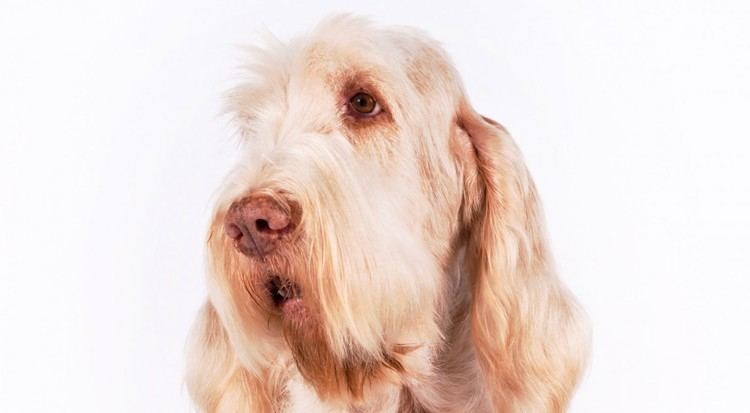
It is traditionally used for hunting, pointing, and retrieving game (HPR), but, in addition to that purpose, the intelligent and strong Spinone may be practically anything ranging from a companion to an assistance dog.
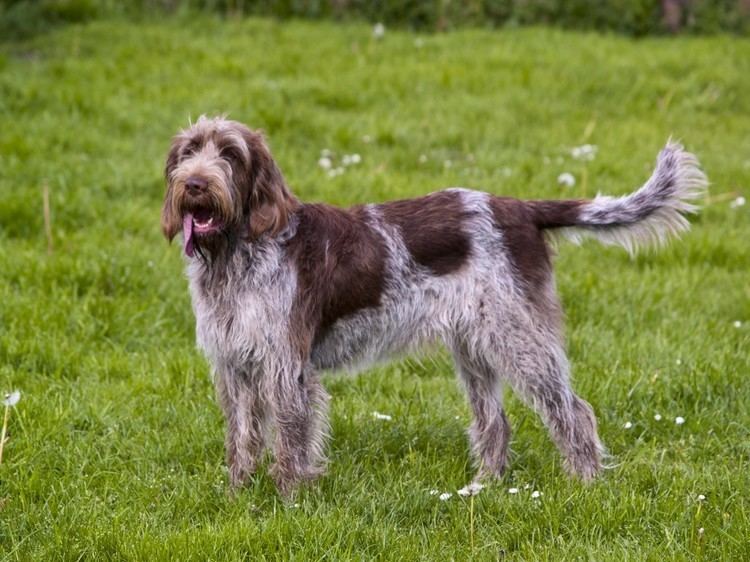
Appearance
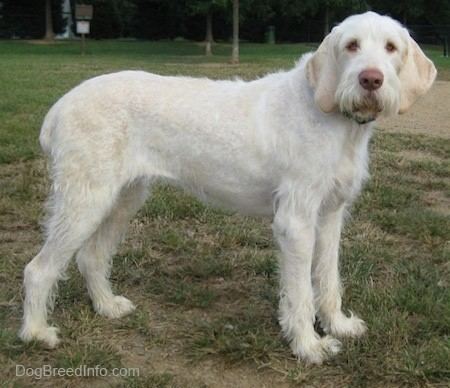
The Spinone has a square build (the length of the body is approximately equal to the height at the withers). It is a strong-boned, solidly built dog with a well-muscled body and limbs that are suited to almost any kind of terrain. A brown and white Spinone can sometimes be confused with a German Wirehaired Pointer by someone unfamiliar with the breeds. However, the long head and pronounced occipital are unique to the breed. He has an expression that shows intelligence and understanding and is often described as having human-like eyes. The tail of the working Spinone is customarily docked at half its length (approx 5.5 to 8 inches or 140 to 200 mm from the base of the tail). Non-working UK based Italian Spinones are no longer docked, in accordance with current legislation. Even as adults, Spinoni retain disproportionate, puppy-like, webbed paws which make them powerful swimmers.
Coat

The coat is tough, slightly wiry, and close fitting. The preferred length is 1.5 to 2.5 in (3.8 to 6.4 cm) on the body; however, the ears, muzzle, head, and parts of the legs and feet are covered with shorter hair. Eyebrows have longer and stiffer hair; longer but softer hair covers cheeks and muzzle, creating a profuse moustache and beard.
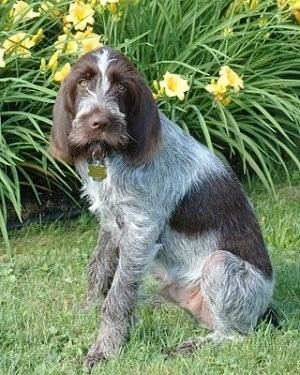
The Spinone should not have an undercoat. A long, soft or silky coat is undesired and is a sign of excessive grooming.
Color

Acceptable variants (UK and US) are solid white, white with orange markings, orange roan with or without orange markings, white with brown markings, and brown roan with or without brown markings. Pigment of skin, nose, lips, and the pads on their feet should be a fleshy red-orange in white dogs, slightly darker in orange and brown roan dogs. The white and orange coloration is unique amongst the wire-haired gun dogs. .
Height and weight
Height at withers:
Weight should be in the correct proportion to size and structure:
Temperament
The Spinone is easy going, docile, and affectionate towards both people and dogs. It is well known for being loving and gentle with children. Its extremely patient nature also helps with this, but children should be taught not to take advantage of this trait. It is loyal to those it knows and still friendly to those it does not. The breed is not known for any aggression, but any dog breed can develop fear aggression if not properly socialized during the "window of socialization" from ages 6 weeks to 14 weeks.
Centuries of working with man as a hunting companion has created a loyal, intelligent dog that is easily trained, although some can be stubborn about performing a learned task if they see no point in it. Because they are sensitive, motivational training works best for this breed, as this gentle dog's feelings can easily be hurt when handled incorrectly.
The Spinone can be a very active breed, but it is not a racy dog like most other hunting breeds. The Spinone typically moves at the relaxed trot that is characteristic of the breed. It has often been called the perfect dog to run or jog with, because it will not run off in front and leave its human companion struggling to keep up as it prefers the slower pace itself. It can be more than happy in a small yard and does not necessarily need acres of land. The small garden combined with regular walks would suit a Spinone well.
In part due to its long beard and lip folds, the Spinone can have a tendency to slobber.
Health
Like all purebred dogs, it has its share of health problems, but careful breeding is helping the situation cease.
Life expectancy
In 2004, The Kennel Club in the United Kingdom conducted a breed health survey [1] which found the average life expectancy of Italian Spinone to be 8.7 years.
Known medical issues
History
The breed is believed to have been developed in the Piedmont region of Italy. As the Spinone is a very ancient breed (it is believed to be one of the oldest gun dogs in existence), it is not known exactly what the origins of the breed are; there are many different theories. Some of these claim that the Spinone could have originated in Italy, France, Spain, Russia, Greece, or Celtic Ireland.
Some people familiar with the history of the breed claim that the Spinone descended from the now-extinct Spanish Pointer, whilst others claim that it was the ancient Russian Setter that is responsible for the breed we know today. An even more popular theory is that Greek traders brought coarse-haired setters to Italy during the height of the Roman empire, where the dogs were then crossed with various others and the modern Spinone eventually emerged.
The French claim that the Spinone has descended from crosses of several French pointing breeds, whilst the Italians believe the Spinone is the ancestor of the Wirehaired Pointing Griffon, the German Wirehaired Pointer, and the Pudelpointer. Any one of these claims could be true; perhaps several of them are correct.
During the Second World War, the Spinone became close to extinct. Both the war and the fact that Italian hunters had begun using other breeds (such as setters, pointers, and spaniels) in the hunt, whereas before it was primarily the Spinone. Many breeders had to resort to crossing the Spinone with other wire-haired breeds, such as the Boulet, Wirehaired Pointing Griffon and German Wirehaired Pointer.
The breed was not officially known as "Spinone" until the early 19th century. Before then, some areas knew the breed as the "Spinoso". The breed may have been named after an Italian thorn bush, the spino, which was a favorite hiding place for small game because for larger animals it was practically impenetrable. Only thick-skinned, coarse-haired animals could fight through the branches unharmed to locate the game. The Spinone was the breed most capable of doing so, and, perhaps, therefore the name was formed.
Today the Bracco Italiano is the most popular hunting dog in Italy, although the Spinone is still common. The Bracco is a racier, higher energy dog, while the Spinone excels at hunting close or in dense cover, and in retrieving from water.
The Duchess of Northumberland has a spinone, called Fuzzy.
